Yasuhiro Sogawa
Enhancing Reasoning Capabilities of LLMs via Principled Synthetic Logic Corpus
Nov 19, 2024Abstract:Large language models (LLMs) are capable of solving a wide range of tasks, yet they have struggled with reasoning. To address this, we propose $\textbf{Additional Logic Training (ALT)}$, which aims to enhance LLMs' reasoning capabilities by program-generated logical reasoning samples. We first establish principles for designing high-quality samples by integrating symbolic logic theory and previous empirical insights. Then, based on these principles, we construct a synthetic corpus named $\textbf{Formal Logic Deduction Diverse}$ ($\textbf{FLD}$$^{\times 2}$), comprising numerous samples of multi-step deduction with unknown facts, diverse reasoning rules, diverse linguistic expressions, and challenging distractors. Finally, we empirically show that ALT on FLD$^{\times2}$ substantially enhances the reasoning capabilities of state-of-the-art LLMs, including LLaMA-3.1-70B. Improvements include gains of up to 30 points on logical reasoning benchmarks, up to 10 points on math and coding benchmarks, and 5 points on the benchmark suite BBH.
Layout Generation Agents with Large Language Models
May 13, 2024Abstract:In recent years, there has been an increasing demand for customizable 3D virtual spaces. Due to the significant human effort required to create these virtual spaces, there is a need for efficiency in virtual space creation. While existing studies have proposed methods for automatically generating layouts such as floor plans and furniture arrangements, these methods only generate text indicating the layout structure based on user instructions, without utilizing the information obtained during the generation process. In this study, we propose an agent-driven layout generation system using the GPT-4V multimodal large language model and validate its effectiveness. Specifically, the language model manipulates agents to sequentially place objects in the virtual space, thus generating layouts that reflect user instructions. Experimental results confirm that our proposed method can generate virtual spaces reflecting user instructions with a high success rate. Additionally, we successfully identified elements contributing to the improvement in behavior generation performance through ablation study.
Text Retrieval with Multi-Stage Re-Ranking Models
Nov 14, 2023Abstract:The text retrieval is the task of retrieving similar documents to a search query, and it is important to improve retrieval accuracy while maintaining a certain level of retrieval speed. Existing studies have reported accuracy improvements using language models, but many of these do not take into account the reduction in search speed that comes with increased performance. In this study, we propose three-stage re-ranking model using model ensembles or larger language models to improve search accuracy while minimizing the search delay. We ranked the documents by BM25 and language models, and then re-ranks by a model ensemble or a larger language model for documents with high similarity to the query. In our experiments, we train the MiniLM language model on the MS-MARCO dataset and evaluate it in a zero-shot setting. Our proposed method achieves higher retrieval accuracy while reducing the retrieval speed decay.
LARCH: Large Language Model-based Automatic Readme Creation with Heuristics
Aug 22, 2023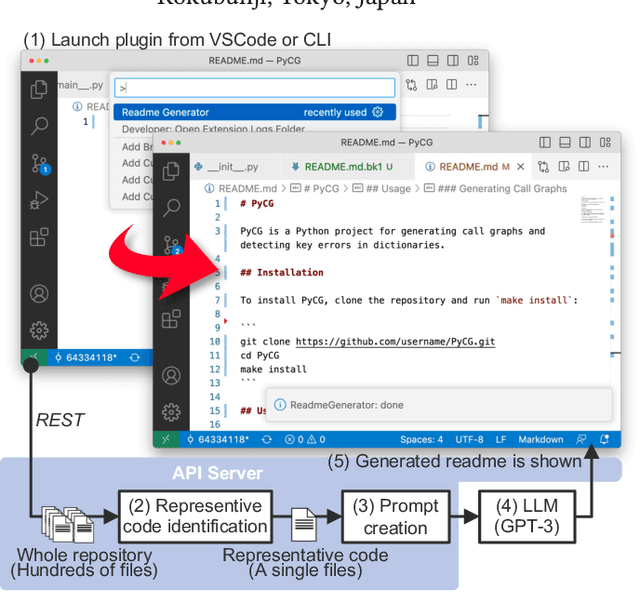
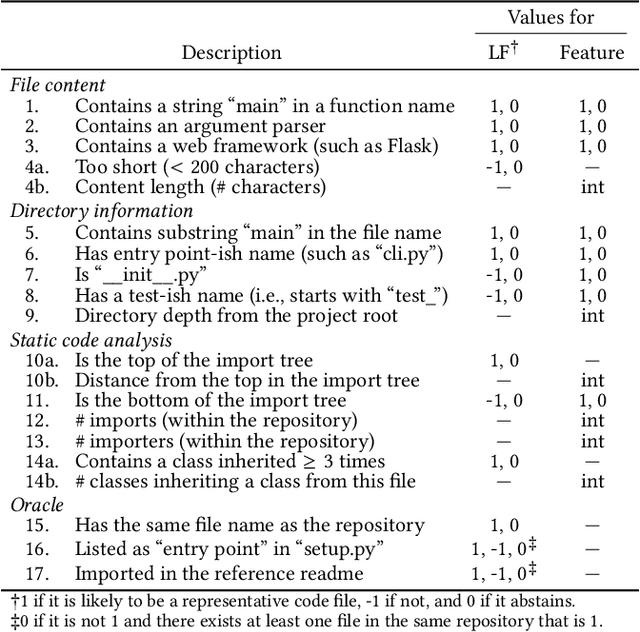
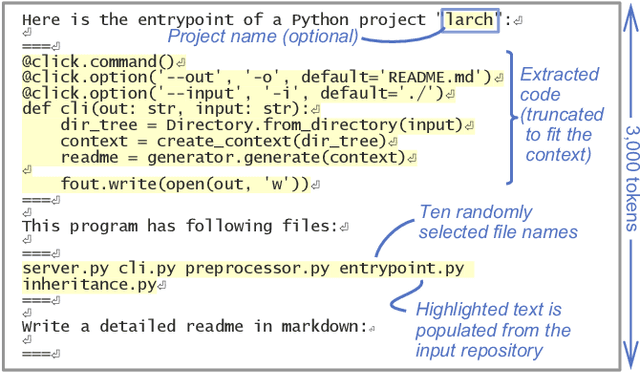

Abstract:Writing a readme is a crucial aspect of software development as it plays a vital role in managing and reusing program code. Though it is a pain point for many developers, automatically creating one remains a challenge even with the recent advancements in large language models (LLMs), because it requires generating an abstract description from thousands of lines of code. In this demo paper, we show that LLMs are capable of generating a coherent and factually correct readmes if we can identify a code fragment that is representative of the repository. Building upon this finding, we developed LARCH (LLM-based Automatic Readme Creation with Heuristics) which leverages representative code identification with heuristics and weak supervision. Through human and automated evaluations, we illustrate that LARCH can generate coherent and factually correct readmes in the majority of cases, outperforming a baseline that does not rely on representative code identification. We have made LARCH open-source and provided a cross-platform Visual Studio Code interface and command-line interface, accessible at https://github.com/hitachi-nlp/larch. A demo video showcasing LARCH's capabilities is available at https://youtu.be/ZUKkh5ED-O4.
* This is a pre-print of a paper accepted at CIKM'23 Demo. Refer to the DOI URL for the original publication
Learning Deductive Reasoning from Synthetic Corpus based on Formal Logic
Aug 11, 2023Abstract:We study a synthetic corpus-based approach for language models (LMs) to acquire logical deductive reasoning ability. The previous studies generated deduction examples using specific sets of deduction rules. However, these rules were limited or otherwise arbitrary. This can limit the generalizability of acquired deductive reasoning ability. We rethink this and adopt a well-grounded set of deduction rules based on formal logic theory, which can derive any other deduction rules when combined in a multistep way. We empirically verify that LMs trained on the proposed corpora, which we name $\textbf{FLD}$ ($\textbf{F}$ormal $\textbf{L}$ogic $\textbf{D}$eduction), acquire more generalizable deductive reasoning ability. Furthermore, we identify the aspects of deductive reasoning ability on which deduction corpora can enhance LMs and those on which they cannot. Finally, on the basis of these results, we discuss the future directions for applying deduction corpora or other approaches for each aspect. We release the code, data, and models.
How do different tokenizers perform on downstream tasks in scriptio continua languages?: A case study in Japanese
Jun 16, 2023Abstract:This paper investigates the effect of tokenizers on the downstream performance of pretrained language models (PLMs) in scriptio continua languages where no explicit spaces exist between words, using Japanese as a case study. The tokenizer for such languages often consists of a morphological analyzer and a subword tokenizer, requiring us to conduct a comprehensive study of all possible pairs. However, previous studies lack this comprehensiveness. We therefore train extensive sets of tokenizers, build a PLM using each, and measure the downstream performance on a wide range of tasks. Our results demonstrate that each downstream task has a different optimal morphological analyzer, and that it is better to use Byte-Pair-Encoding or Unigram rather than WordPiece as a subword tokenizer, regardless of the type of task.
How does the task complexity of masked pretraining objectives affect downstream performance?
May 18, 2023Abstract:Masked language modeling (MLM) is a widely used self-supervised pretraining objective, where a model needs to predict an original token that is replaced with a mask given contexts. Although simpler and computationally efficient pretraining objectives, e.g., predicting the first character of a masked token, have recently shown comparable results to MLM, no objectives with a masking scheme actually outperform it in downstream tasks. Motivated by the assumption that their lack of complexity plays a vital role in the degradation, we validate whether more complex masked objectives can achieve better results and investigate how much complexity they should have to perform comparably to MLM. Our results using GLUE, SQuAD, and Universal Dependencies benchmarks demonstrate that more complicated objectives tend to show better downstream results with at least half of the MLM complexity needed to perform comparably to MLM. Finally, we discuss how we should pretrain a model using a masked objective from the task complexity perspective.
Controlling keywords and their positions in text generation
Apr 19, 2023Abstract:One of the challenges in text generation is to control generation as intended by a user. Previous studies have proposed to specify the keywords that should be included in the generated text. However, this is insufficient to generate text which reflect the user intent. For example, placing the important keyword beginning of the text would helps attract the reader's attention, but existing methods do not enable such flexible control. In this paper, we tackle a novel task of controlling not only keywords but also the position of each keyword in the text generation. To this end, we show that a method using special tokens can control the relative position of keywords. Experimental results on summarization and story generation tasks show that the proposed method can control keywords and their positions. We also demonstrate that controlling the keyword positions can generate summary texts that are closer to the user's intent than baseline. We release our code.
Team Hitachi at SemEval-2023 Task 3: Exploring Cross-lingual Multi-task Strategies for Genre and Framing Detection in Online News
Mar 03, 2023Abstract:This paper explains the participation of team Hitachi to SemEval-2023 Task 3 "Detecting the genre, the framing, and the persuasion techniques in online news in a multi-lingual setup." Based on the multilingual, multi-task nature of the task and the setting that training data is limited, we investigated different strategies for training the pretrained language models under low resource settings. Through extensive experiments, we found that (a) cross-lingual/multi-task training, and (b) collecting an external balanced dataset, can benefit the genre and framing detection. We constructed ensemble models from the results and achieved the highest macro-averaged F1 scores in Italian and Russian genre categorization subtasks.
An Interactive Greedy Approach to Group Sparsity in High Dimensions
Sep 26, 2018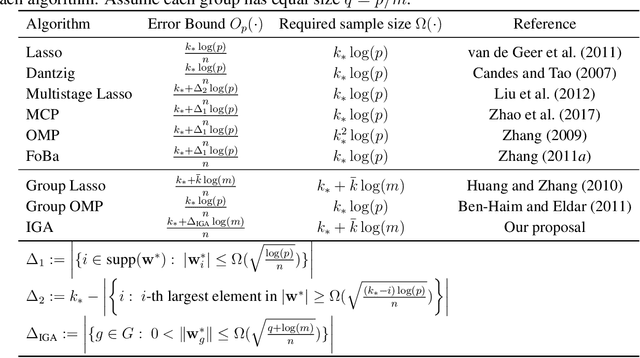
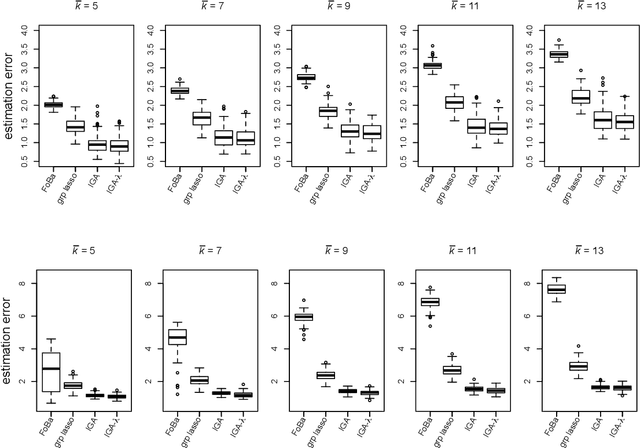
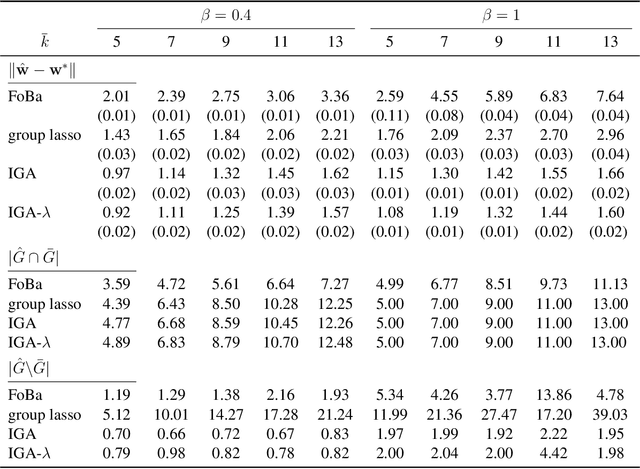
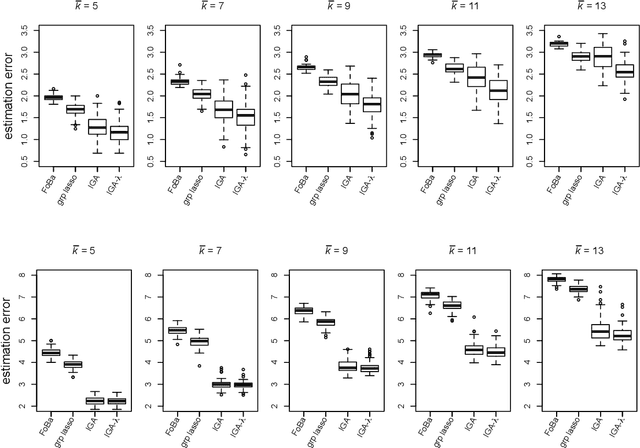
Abstract:Sparsity learning with known grouping structure has received considerable attention due to wide modern applications in high-dimensional data analysis. Although advantages of using group information have been well-studied by shrinkage-based approaches, benefits of group sparsity have not been well-documented for greedy-type methods, which much limits our understanding and use of this important class of methods. In this paper, generalizing from a popular forward-backward greedy approach, we propose a new interactive greedy algorithm for group sparsity learning and prove that the proposed greedy-type algorithm attains the desired benefits of group sparsity under high dimensional settings. An estimation error bound refining other existing methods and a guarantee for group support recovery are also established simultaneously. In addition, we incorporate a general M-estimation framework and introduce an interactive feature to allow extra algorithm flexibility without compromise in theoretical properties. The promising use of our proposal is demonstrated through numerical evaluations including a real industrial application in human activity recognition at home. Supplementary materials for this article are available online.
 Add to Chrome
Add to Chrome Add to Firefox
Add to Firefox Add to Edge
Add to Edge